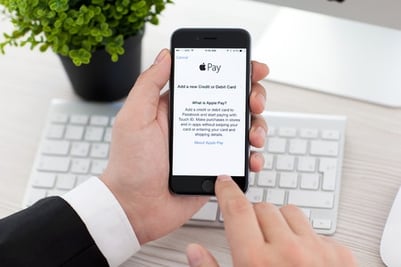Share this
What You Should Know About Apple Pay
by Robert McNicholas on June 23, 2015
 We’ve been hearing a lot about Apple Pay. But what is it, and what impact will it have on your business?
We’ve been hearing a lot about Apple Pay. But what is it, and what impact will it have on your business?
Last autumn, we wrote a post on the TechSperts Talk blog about new payment methods that rely on NFC (Near Field Communication) technology—a radio signal that fosters communication between nearby mobile devices. To the tune of 220,000 retailers strong, this technology is already gaining rapid acceptance, thanks—at least in part—to Apple Pay.
This raises questions for the small business. What is Apple Pay? How does it work? Is your business doomed to die a slow death of sales attrition if you don’t adopt it this very instant?
And that’s what we’ll talk about today.
What Is Apple Pay?
Apple Pay is a payment solution. While the payment comes out of the customer’s credit or debit card, there’s no actual card swiping (as is common for most POS terminals). Information is sent from their iPhone 6, Apple Watch, or iPhone 6 Plus to your contactless (i.e., NFC-enabled) terminal.
Why not all iPhone iterations? To stay secure, Apple Pay relies on a special element known aptly as a Secure Element. This element is only available in the iPhone 6, 6 Plus, and the Apple Watch.
How Does Apple Pay Work?
For the customer, they simply add a card to the Passbook app and select the Apple Pay option when it comes time to check out. This works in certain third-party apps as well as in a growing number of retail stores.
When the customer chooses to pay with Apple Pay, a unique device account number is created, and the payment is authorized when the customer’s fingerprint is accepted by the device’s built-in fingerprint scanner.
Aside from a brief summary of recent purchases, no transaction data is stored by Apple Pay. This makes it more secure than magnetic-strip card data, which can be reused multiple times. If the device is lost, it can be “frozen” via Apple’s iCloud Lost Mode. This locks the phone and disables Apple Pay.
For retailers, the key ingredient in setting up Apple Pay is having a contactless point of sale terminal. Once you have one of these, you can contact your payment provider (First Data, Bank of America Merchant Services, WorldPay, etc.) about accepting Apple Pay. Apple doesn’t charge any additional fees on the transaction and normal debit/credit card processing rules apply.
Oh, and you’ll need one more thing: some of Apple’s handy little decals to identify your business as Apple Pay-ready. For more information, check out the Apple Pay FAQs.
Do I Need To Add Apple Pay To My Store / Point of Sale?
The short answer is no. More precisely, the answer is no, not immediately. Even the hippest, techie-est crowd still carries cash—or some form of plastic. But NFC technologies are definitely worth keeping an eye on. Who knows? In the future, we might all be paying with Apple Pay or one of its equivalents.
Featured image copyright: <a href='http://www.123rf.com/profile_prykhodov'>prykhodo
Share this
- Featured (119)
- Best Practices (75)
- Business (72)
- Small Business (72)
- Security (43)
- Managed Services (34)
- Business Growth (32)
- Technology News (26)
- Google For Work (22)
- it support (15)
- Social Media (13)
- Technology (11)
- Malware (10)
- Google (9)
- News (9)
- Productivity (9)
- Technology Support (8)
- Cloud (6)
- seo (6)
- Backup Storage (5)
- Website (5)
- Communication (4)
- Ransomware (4)
- Research (4)
- Analytics (3)
- Windows (2)
- anti malware (2)
- email (2)
- how to (2)
- laptops (2)
- mobile (2)
- Hubspot (1)
- data recovery (1)
- twitter (1)
- July 2024 (1)
- June 2024 (2)
- May 2024 (2)
- April 2024 (2)
- March 2024 (2)
- November 2022 (3)
- October 2022 (1)
- September 2022 (3)
- August 2022 (3)
- December 2021 (3)
- November 2021 (3)
- October 2021 (1)
- September 2021 (3)
- August 2021 (3)
- July 2021 (1)
- March 2021 (1)
- February 2021 (7)
- January 2021 (1)
- March 2020 (1)
- August 2019 (1)
- April 2019 (4)
- March 2019 (6)
- December 2018 (10)
- November 2018 (10)
- August 2018 (1)
- July 2018 (9)
- June 2018 (4)
- May 2018 (4)
- October 2017 (3)
- September 2017 (6)
- August 2017 (6)
- July 2017 (12)
- June 2017 (12)
- May 2017 (3)
- March 2017 (5)
- February 2017 (2)
- August 2016 (2)
- June 2016 (4)
- January 2016 (1)
- December 2015 (3)
- November 2015 (3)
- October 2015 (3)
- September 2015 (3)
- August 2015 (2)
- July 2015 (4)
- June 2015 (3)
- May 2015 (2)
- April 2015 (1)
- March 2015 (1)
- February 2015 (1)
- January 2015 (2)
- November 2014 (4)
- October 2014 (11)
- September 2014 (5)
- August 2014 (6)
- July 2014 (6)
- June 2014 (8)
- May 2014 (3)
- April 2014 (3)
- March 2014 (2)

